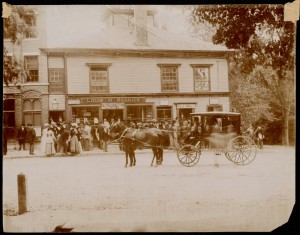As we approach the annual town meeting it’s interesting to see what constituted important Lenox town business in the late nineteenth, early 20th century.

Pauper Costs
One issue we’re not concerned with these days is the cost of paupers. More than 10% of the town budget went to the support of paupers and there was apparently a constant effort to get people off the town’s rolls and onto someone else’s. For instance, in 1868, the town warrant identified Mrs. Garnier as a pauper who was the widow of Frank Garnier who had been born in France – which meant she should be supported by the state alms house. Apparently the argument didn’t fly as Mrs. Garnier shows up in several subsequent years on the pauper rolls.
The support for paupers tells sad tales. Here is the 1875 detail for one family:
- J.F. Morrell coal for Mrs. Farrington $10.50
- F. McDonald good for Mrs. Farrington $15.79
- ” $11.53
- Otis Clapp pasturing Mrs. Farrington’s cow $10.40
- J.F. Morrell coal for Farrington family $13.94
- E. McDonald supplies Farrington family $24.29
- C.G. Banks attending funeral for Farrington child $ 9.00
- D. Wood wood for Farrington family $ 8.00
- S.P. Millard coffin for Farrington child $15.00
- Perry & Co. coal to Mrs. Farrington’s $18.63
- E.McDonald goods Farrington family $10.27
- Dr. C.E. Heath services for Farrington family $78.00
- Wm. Perry wood, potatoes Farrington family $ 8.00
- Perry & Co. coal Farrington family $ 8.46
- D.W, Noyes medecine Farrington family $36.58
- Thatcher and Stone supplies for Farrington family $13.20
- G.F. Washburn supplies for Farrington family $176.35
Unfortunately the Farringtons show up again in subsequent years.
In 1889 the town report noted that the number of persons requiring support was increasing and the costs kept exceeding allocation. It was recommended consideration be given to purchasing a farm where they could be taken care of.
Sewers
In 1889, the town set aside the considerable sum of $7500 for new sewers and disposal field. Ernest Bowditch was the engineer and we hope he did a great job because we’re probably still using some of those pipes.
Schools
In 1875, primary (common) school and high school were still in the Academy building. The School Committee had a slight surplus that year so was to be able to buy some advanced equipment – suitable maps and globes.
The school committee was pleased to continue using graduates of the high school to teach in the common school (so money did not go out of town). The methods of instruction had been improved with the help of Mr. Walton of the State Board of Education and the school committee said they “hope for further assistance from him.” (Be careful what you wish for)
Trees
In hindsight, the 1915 report of tree warden F. Francis Mackey is so sad, it is repeated here almost verbatim:
“Early in March the work of removing tent caterpillar nests from the trees on the highways was taken up. Most of the wild cherry and wild apple trees were cut down and the egg clusters of the caterpillar destroyed………The maples on Court House Hill are in very poor condition being too old for any effective repairs, and I would advise the planting of elms on that street as in a year or two most of the maples will have to be removed. …. There is a movement throughout the state for the planting of more shade trees. The Mass. Forestry Association has offered a prize of 200 trees for the town doing the most planting during the year. The Lenox Improvement Society has already planted about 50 elms, and I would advise that 50 more be planted, trees being needed on Christian Hill in New Lenox and Lenox Dale. …”
The next report is from the Moth Superintendent – so we can’t say our forefathers weren’t tried to beat back the gypsy moth problem.
Thanks to the Lenox Historical Society for Town Reports.